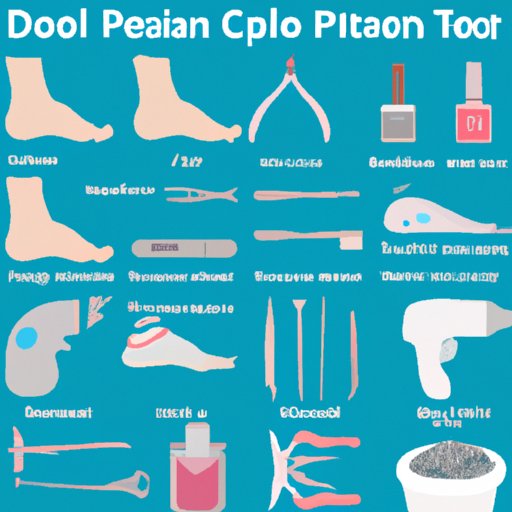Introduction
Toenail removal is a procedure that involves the trimming or cutting of an overgrown toenail. This is done to reduce the risk of infection, improve the aesthetic appearance of the toe, provide relief from pain and discomfort, and promote healing of an injury. In some cases, toenail removal may also be necessary to treat fungal infections, ingrown toenails, or other conditions.

Use Clippers or Nippers to Cut the Toenail
The first step in removing a toenail is to cut it with clippers or nippers. It is important to use sharp, clean tools to avoid causing any damage to the nail or surrounding skin. Before beginning, make sure to cut the nails straight across rather than rounding them off at the edges. Additionally, try not to cut too close to the skin as this can lead to infection.
When cutting the toenail, you should hold the clipper or nipper at a slight angle and apply gentle pressure. Do not press too hard as this can cause the nail to split. You should also take care to avoid cutting into the skin around the nail.
Soak the Toe in Warm Water and Epsom Salts
Once the toenail has been trimmed, it is important to soak the toe in warm water and Epsom salts. The Epsom salts will help to soften the toenail and make it easier to remove. Soaking the toe for 15 minutes in a bowl of warm water and one tablespoon of Epsom salts will also help to reduce inflammation and provide relief from pain and discomfort.
In addition to providing relief from pain and discomfort, soaking the toe in warm water and Epsom salts can also help to reduce the risk of infection by washing away any bacteria or debris that may be present.

Gently Push Back the Toenail with a Pusher
Once the toenail has been softened, you can begin to gently push it back with a pusher. A pusher is a small metal or plastic tool that is designed to be used on toenails. When selecting a pusher, make sure to choose one that is the right size and shape for your toe.
It is important to use gentle pressure when pushing back the toenail. If you press too hard, you could cause further damage to the nail or surrounding skin. You should also take care to avoid pushing the toenail too far back as this could result in an ingrown toenail.
File Down the Toenail
Once the toenail has been pushed back, you can begin to file it down. When selecting a file, make sure to choose one that is specifically designed for toenails. It is important to use a light touch when filing the toenail and avoid pressing too hard. Additionally, it is best to move the file in one direction rather than back and forth to prevent any splitting or tearing of the nail.
Filing the toenail down will help to keep it at a manageable length and reduce the risk of ingrown toenails. It is important to file the nail regularly to ensure that it remains healthy and free from infection.
Use a Dremel Tool for Tough Toenails
If you have a particularly tough toenail, you may need to use a Dremel tool to remove it. A Dremel tool is a handheld rotary tool that is often used for grinding, sanding, and polishing. It is ideal for removing tough toenails as it can quickly and effectively grind away the excess nail.
When using a Dremel tool, it is important to take safety precautions such as wearing protective eyewear and gloves. Additionally, it is best to start at a low speed and gradually increase the speed as needed.

Utilize an Electric Nail Grinder
An electric nail grinder is another tool that can be used to remove tough toenails. An electric nail grinder is a handheld device that uses rotating discs to grind away the excess nail. It is often used by professionals to quickly and safely remove tough toenails.
When using an electric nail grinder, it is important to take the same safety precautions as with a Dremel tool. Additionally, you should only use the grinder on dry nails and never on wet or damp nails.
Talk to a Podiatrist for Professional Assistance
If you are having difficulty removing a toenail or if you have an underlying condition that requires professional care, it is best to talk to a podiatrist. A podiatrist is a doctor who specializes in the diagnosis and treatment of foot and ankle conditions. They can provide advice and guidance on how to safely and effectively remove a toenail.
A podiatrist can also provide treatments for conditions such as fungal infections, ingrown toenails, and other ailments. They can also provide preventive care and advice on how to keep your feet healthy and free from injury.
Conclusion
Toenail removal is a common procedure that is often done to reduce the risk of infection, improve the aesthetic appearance of the toe, provide relief from pain and discomfort, and promote healing of an injury. There are a variety of methods that can be used to remove a toenail including cutting it with clippers or nippers, soaking it in warm water and Epsom salts, pushing it back with a pusher, filing it down, using a Dremel tool, and utilizing an electric nail grinder. In some cases, it may be necessary to seek professional help from a podiatrist.


